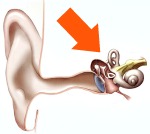University noise engineer gets “definite infrasound readings from turbines” (Australia)
Dec 7, 2010
“Mr Hood hit the headlines last year when he undertook limited sound testing at Waubra in response to residents who reported experiencing nausea, headaches and sleep deprivation.
“Initial results showed definite infrasound readings from turbines.
“Infrasound is undetectable by the human ear and is not measured by normal wind farm sound monitoring equipment.”
 ·
·
—Brendan Gullifer, The Courier.com.au (12/6/10)
The real problem with the wind turbine industry is that we should be heralding this clean and green technology — but instead we’re pitting neighbour against neighbour.
That’s the view of recently retired University of Ballarat engineering lecturer Graeme Hood.
Mr Hood hit the headlines last year when he undertook limited sound testing at Waubra in response to residents who reported experiencing nausea, headaches and sleep deprivation.
Initial results showed definite infrasound readings from turbines.
Infrasound is undetectable by the human ear and is not measured by normal wind farm sound monitoring equipment.
According to a recent British study, infrasound can trigger anxiety, sadness, revulsion and fear.
And the jury is still out on other effects.
Mr Hood is quick not to lay the blame at the feet of the wind farm companies.
“Obviously, they don’t want to hurt people,” he says. “They don’t want to make people sick because that’s not good business.”
He says the companies are legally operating within the confines of existing wind-farm legislation.
“But the people who are objecting to the wind farms, the people who are getting sick, are not going to go away,” he says.
“Companies might be able to buy a couple of people out, but that’s not the way to fix this.
“We need to find out what the problem is.”
Mr Hood says people who complain of so-called wind turbine syndrome are immediately ostracised.
“If everyone’s problem in relation to these things was psychological, that would be a breakthrough,” Mr Hood says.
“Then we could treat it. And then we wouldn’t have a problem.
“It’s an issue for the government. But not just this government. I hear the same story in South Australia, in Queensland, in New South Wales, even overseas.
“I’ve got emails from people in England saying we’ve got turbines near us, we’re getting sick and we complain. And we are now treated like lepers in our community.”
Mr Hood says the issue is complex, but the next step is relatively simple.
“We need to spend some time and some money and get in there, free of politics, and see what’s going on.
“I’d dearly love it if someone announced a study, if someone was prepared to get in there and talk to people properly, take measurements and find out once and for all what’s going on and how we fix the problem.”
According to a Victorian government website, the state has eight operating wind farms comprising 266 turbines. Another 28 wind farms comprising 1322 turbines have been approved but are not yet operational. Another 21 wind farms are in the feasibility stage.
Both the Victorian and federal governments say there is no proof of any health problems caused by turbines.
